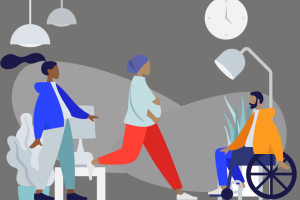Exercise: Equitable Access
Equitable Access
Learning Objectives
At the end of this exercise, participants will be able to:
- Evaluate various aspects of accessible web design.
- Design accessible aspects for their courses; such as
- Find and draft alternative text for an image.
- Add or research ways to incorporate closed captions.
- Identify content chunking.
Suggested Materials
Presenters
- Presenter display, such as connected television or projector.
- Various examples of accessible code snippets and workflows, such as alternative text and closed captioning.
- Sticky notes, easel and post-it sizes if available.
- Writing utensils to hand out to participants.
Participants
- Computer
- Post-it notes and writing utensil (provided by presenter)
Estimated Activity Time
Sixty minutes.
Exercise Outline
Whether situational or temporary, 61 million adults in the United States live with a disability. By designing with accessibility first in mind, we have the best chance at reaching the widest possible audience without working backwards to correct when – and sometimes only when – a student self-identifies as needing accommodations.
Accommodations sent out by accessibility services departments let faculty – and by extension Instructional Designers – know more about their students to be able to provide a similar experience for them and their peers. This can take the form of extra time to submit assignments, include alternative text on images, or the addition of closed caption to instructor-created videos.
However, students who don’t self-identify with an accessibility services department may not be able to fully engage with the meticulously curated content faculty have selected to serve their learning objectives: Just because you don’t know that someone needs an accommodation doesn’t mean than nobody does.
The following exercises have been designed to encourage deeper thought into the process of designing and presenting content for equitable access by all.

Exercise Guidelines
- Consider this blog post from EdX – Optimal Video Length for Student Engagement and ask the following questions:
- Does your video content hold up to the suggested timing? If so, are captions included on each of them? If not, do you know how to add them?
- After reading Penning Alt Text Made Me a Better Writer, consider how you could use descriptive text for course images. If you are already using alternative text, how might you encourage other faculty to use it – beyond HTML Living Standard requirements. If you aren’t using alternative text, do you know how to add it?
- Let’s challenge your frame of reference on disability and what accessibility means to you. Is there an icon or image that presents accessibility in a new frame of reference for you or your students?
- Search the web for an image that represents disability to you: This can be a ramp, glasses, pictures with captions – don’t limit yourself.
Alternative Text Example and Consideration
- Is your image informational? The text alternative should convey the meaning or content that is displayed visually, which typically isn’t a literal description of the image. (Source: Web Accessibility Tutorials – Images)
- Using
<figure>, review an example from Mozilla on code usage.
- How are you leveraging web design principles to chunk out larger portions of text on a page? Do you utilize headers and line breaks – or know where the options are in the Learning Management System editor?
Chunking Examples
- For users on the autistic spectrum, the United Kingdom Home Office suggests using bulleted lists rather than a wall of text.
- The World Wide Web Consortium has a document on making content usable for people with cognitive and learning disabilities, with a focus on content chunking.
- Want to go further with your design? Review HTML Semantic Elements to add even more clarity to your courses.
-
A semantic element clearly describes its meaning to both the browser and the developer.
-
- Related to equitable access and differing backgrounds and lived experiences of your students are word choices taken into consideration when building out content that lives, via text, in perpetuity in your Learning Management System.
- As a starting point, review course content in one of your more text-heavy content pages and, using the Diversity Style Guide, draft out versions of the text to share with others in your workshop. Try a before-and-after approach.
- Now, apply this concept to video and audio recordings in your class – either curated or recorded by yourself.
Word Choice Examples
- In Education: “Parents and families” ought to be written as “Families and caregivers.”
- In Psychology: “Crazy” ought to be written as “People living with a mental illness.” (Source: Diversity Style Guide)
- “Educate students on ableist language and abstain from using it yourself, whether you have disabled students in your class or not.” (Source: How Educators Can Support Accessibility – A11y for Writers)
- New York Times: The Words That Are In and Out With the Biden Administration
